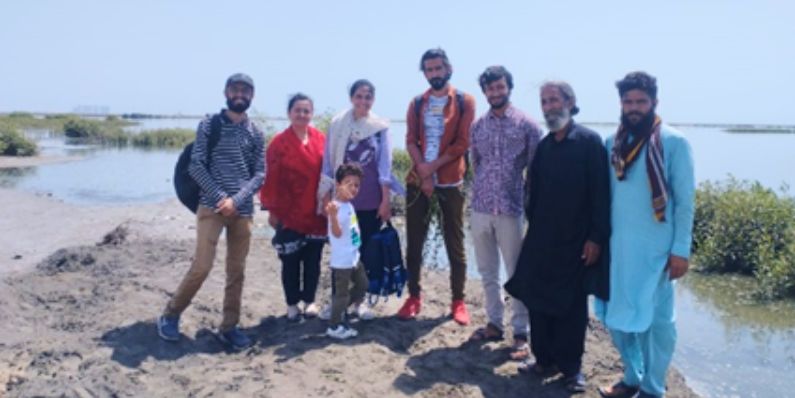Clifton Urban Forest: A nature-based solution for coastal ecosystem restoration
A reflection by Munika Issa and Anila Hayat
It was a hot and dry afternoon in April, and we were standing in the middle of a dense forest, in front of a beautiful lagoon, listening to birds chirping. Yes, a forest in the middle of a concrete jungle.
Karachi, as a city, is devoid of green spaces and is facing urbanisation and expansion. This has resulted in various environmental and climatic issues, including, but not limited to, air pollution, heatwaves, urban flooding, and poor drinking water quality. Clifton Urban Forest was created by an environmental activist, Mr. Masood Lohar, who adopted a park that was once a dumping ground. Mr. Lohar started this journey towards environmental conservation in January 2021.
 Figure 1: a) Showing the layers of waste buried in the ground; and b) the lagoon with flamingos resting in it
Figure 1: a) Showing the layers of waste buried in the ground; and b) the lagoon with flamingos resting in it
Spread over 200 acres of land along the Seaview, the Clifton Urban Forest is a habitat for around 800,000 trees and over 150 different types of aquatic and terrestrial birds. The forest area opens into a mesmerizing lagoon where you can see pink and white flamingos (migratory birds). There are also plenty of ducks afloat on the gentle waves.
The objective behind the creation of this forest is to improve the environmental conditions of the city, reduce the intensity of heatwaves, and prevent cyclones. It aims to improve air quality and, most importantly, to bring back the lost coastal ecosystem of Karachi.
In addition to purifying the air and lowering the temperature, the urban forest has transformed into the largest man-made lagoon in Pakistan, serving as a thriving habitat for diverse wildlife. While conversing with Mr. Lohar, he mentioned that the urban forest has documented approximately 120 species of migrating birds, nesting birds, insects, and animals. We were also informed of another astonishing discovery: in October 2022, two internationally recognised nearly threatened birds, the Black Tailed Godwit and Eurasian Curlew (according to the International Union for Conservation of Nature's red list), were spotted in the lagoon within the urban forest.
 Figure 2: Biodiversity of Clifton Urban Forest
Figure 2: Biodiversity of Clifton Urban Forest
The forest also serves as a nature-based solution for water filtration before it reaches the sea. The creation of a lagoon within the forest aids in treating water that contains high levels of phosphate and nitrate, thereby reducing water pollution and safeguarding marine ecosystems. This innovative approach stands as a model for addressing similar challenges in coastal regions.
This endeavor has become the epitome of successful ecosystem conservation and restoration, contributing significantly to sustainable development goals such as No Poverty, Zero Hunger, Climate Action, Sustainable Cities and Communities, Life below Water, and Life on Earth.
As educators, we are all committed to learning more about green and blue spaces, their importance and ecosystem conservation.


Figure 3: Environmental Education elective course students of AKU-IED with the instructor, Dr. Fozia Parveen, guides and Masood Lohar of Clifton, Karachi urban forest


